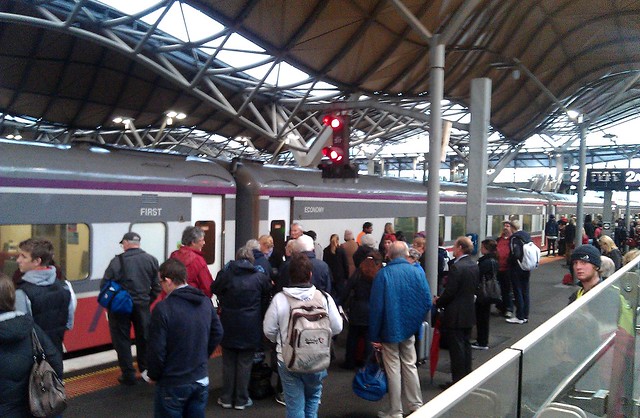The Committee for Ballarat has an excellent campaign going to improve rail services. Unfortunately as sometimes happens, some myths crept into the rhetoric around the launch of the campaign.
“In the early 1900s you could do the Ballarat to Melbourne trip by steam rail in an hour — these days it takes an hour and a half.”
Committee for Ballarat — quoted in the Ballarat Courier
It’s tempting to automatically assume things are crap now, and were better back in the “good old days“. But this is entirely wrong.
We know this because Mark Bau’s excellent web site of old timetables includes a timetable from 1905. This shows, for instance, a stopping train departing Spencer Street at 7:40am, arriving at Ballarat at 11:08am — a trip of some 3 hours and 28 minutes.
An express train (stopping only at Melton, Bacchus Marsh, Ballan, and Ballarat East (quite similar to many express services today) departed at 4:40 and arrived at Ballarat at 7:25, for a travel time of 2 hours and 45 minutes.
Nowadays a typical train stopping along the way might be the 9:07am, arriving Ballarat 10:33 (1 hour and 26 minutes), whereas one of the fastest appears to be the 4:36pm express train, arriving at 5:41pm, or 1 hour and 5 minutes.
In other words, it’s now about twice as fast to catch a train to Ballarat as it was a hundred years ago. (And the services are more frequent, too, though only about hourly at off-peak times.)
Of course, this doesn’t invalidate the aims of the Committee’s Fast Track campaign, which aims for more frequent trains, more reliable services, faster travel times and better mobile phone coverage along the route.

7 replies on “Train myths: a hundred years ago the Ballarat line was quicker – No it wasn’t”
And apparently, the Melbourne-Ballarat railway is the only rail line visable from the moon.
I struck the same thing when I was looking at the Gippsland line and it was not a little bit slower. It was much slower.
It’s ludicrous to claim that a steam service, stopping at every station, could be faster than a train that has a higher top speed and travels at a reasonable pace for most of its journey. Even a car can’t do that trip in an hour.
Why would you claim it is visible from the moon ? Using how big a telescope ? The ability to see things on the ground , even from earth orbit, is not all that great.
The same claims are regularly made about train times between Sydney and Newcastle.
The big difference is the number of new stations which have been added since 80 years ago.
It was suggested that there be express services. But nobody actually takes the train to Sydney from Newcastle. All the commuter patronage comes from the places in between.
Its a bit sinister that woman was murdered in the same street where they abolished the bus service.
I never heard of that street before and then I read about it twice in one week.
Next time you think hourly trains are ordinary, remember that it was only as recent as the 1990s that only 3 trains a day went to Bendigo on a Sunday. I think the schedule had 3 trains leaving Melbourne at 10am, 4pm and 6pm.
Not sure if the Ballarat service was as bad or not.
150 years ago there was a rail service between Ballarat and Geelong, which is now gone.
And in 1851 the London to Bristol steam train had a faster average speed (81.6km/h) than the Sydney-Canberra rail link does today (70.6km/h)!
That is exactly why Dr Paul Wild of the CSIRO proposed High Speed Rail between SYD-ACT in the 1980s.
So a lot of steam trains were faster 150 years ago.